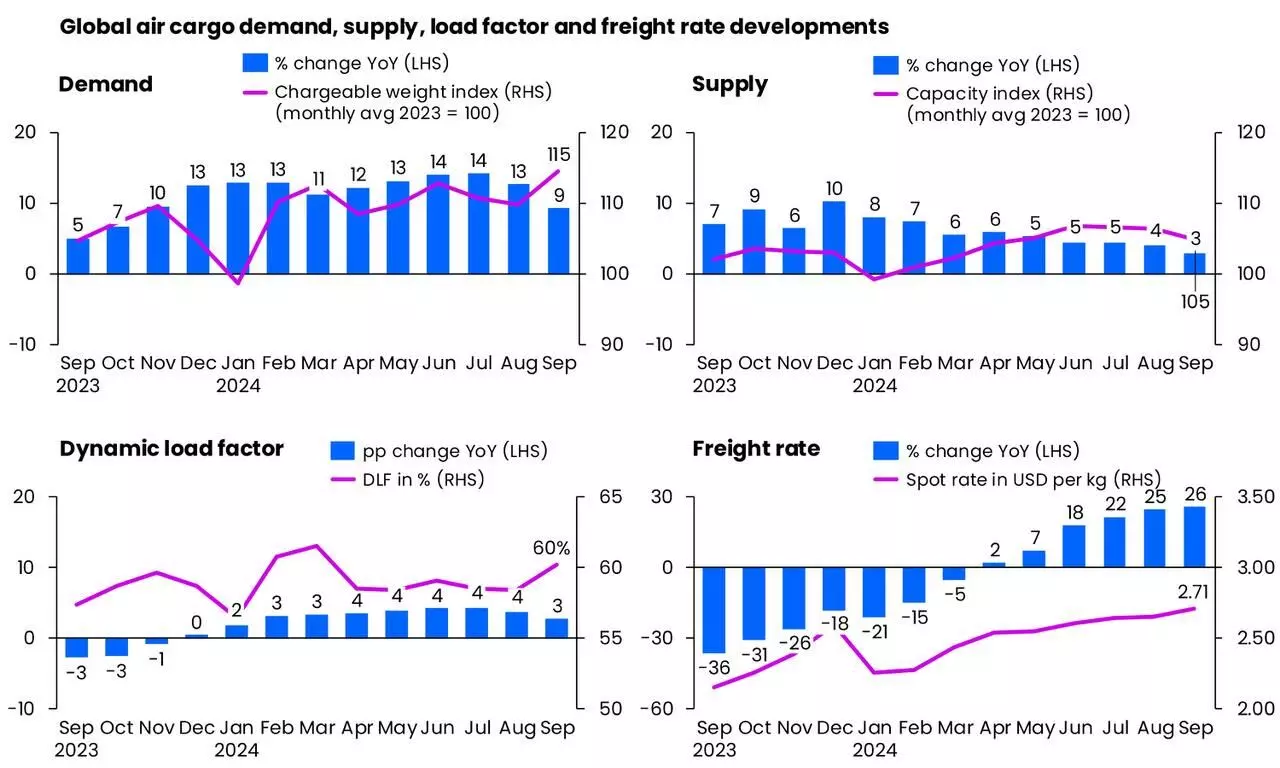
U.S. port strike adds to storm brewing in air cargo market: Xeneta
Airlines and forwarders tempted by short-term gains in Q4 face a fine balancing act.

Source: Xeneta
September’s global air cargo market lived up to analysts’ expectations, becoming the first month of 2024 not to report double-digit growth due to a strong year-on-year comparison but demand still rose nine percent year-on-year, according to the latest data from Xeneta.
"Airlines and freight forwarders now face a fine balancing act between protecting customer relationships and being tempted by short-term revenue gains offered by increasing market volatility, including this week’s strikes at ports on the U.S. East Coast and Gulf Coast," the update added.
Niall van de Wouw, Chief Airfreight Officer, Xeneta says: “September is already old news. October is a whole new ballgame. We could see rates rising very quickly on some trade lanes because of the fear-of-missing-out (FOMO) effect as air cargo capacity leaves the market for the winter, U.S. port workers go on strike and conflict is escalating in the Middle East, potentially bringing further Red Sea disruption for ocean freight.
“I have huge respect for the people who, on a day-to-day basis, are trying to make sense of these challenges and keep the world moving in an efficient manner. How much more can the market take, particularly when there’s so little visibility going forward? Reports suggest supply chains could take 4-6 weeks to recover from just a one-week U.S. ports strike, which takes us into November, the busiest month of the year for air cargo volumes. It’s a difficult situation. Covid was worse but this is an accumulation of many events and things can change very quickly. FOMO is a powerful force."
Growth eased (a little) in September
As expected, September’s global air cargo demand growth showed signs of easing a little, reflecting the strong peak in demand which commenced in September 2023, the update added. "The latest monthly volumes, however, were sustained by persistent e-commerce demand, ocean-to-air shift due to container shipping disruptions, typhoon disruptions and a cargo rush ahead of China’s Golden Week holidays (October 1-7)."
Global air cargo supply grew by only three percent year-on-year in September - its slowest growth rate this year as airlines began their flight schedule adjustments in preparation for winter. Xeneta expects a 20 percent reduction in cargo capacity across the Atlantic this winter, to reflect lower passenger demand.
"Dynamic load factor - Xeneta’s measurement of capacity utilisation based on volume and weight of cargo flown alongside available capacity - continued to rise due to the persistent imbalance between supply (+three percent) and demand (+ nine percent). It increased by three percentage points year-on-year and two percentage points month-on-month, reaching 60 percent in September."
As a result, September’s average global spot rate increased 26 percent to $2.71 per kg, the fourth straight month of double-digit growth and the highest increase this year. "And this occurred against a backdrop of U.S. Gulf Coast kerosene-type jet fuel prices showing a -37 percent year-on-year decline in the same month."
Asia-North America, Europe rates rally
Zooming into the corridor level, spot rates from Asia to North America and Europe topped the chart in September, exceeding the other major global corridors by over $2 per kg. "Most Asia to North America and Europe rates showed single-digit month-on-month increases in September, except for a slight dip from Southeast Asia to North America. As for year-on-year trends, all registered double-digit growth."
Several backhaul corridors from North America and Europe to Asia showed notable month-on-month spot rate growth: Europe to Southeast Asia (+11 percent), North America to Northeast Asia (+ six percent) and North America to Europe (+ four percent). In terms of year-on-year comparison, the largest decline was observed on the Europe to Northeast Asia trade, which decreased by -11 percent due to increased trade imbalances.
Testing Q4 ahead
Global events, van de Wouw says, will now put preparations for this year’s peak season to the test. “As we’ve said before, companies are more prepared this year and the rules of the game have been clarified between airlines and forwarders as well as between forwarders and shippers. There are now more precise agreements in place on how to navigate the storm the market is likely entering.
"There are agreements around rates, surcharges and the timeframes in which they can be applied, but there’s going to be a fine balancing act between maintaining relationships and being tempted by the short-term benefits these market conditions are creating.
“The macroeconomic outlook for 2025 is not fantastic, particularly as it impacts the general freight market. That may make the current volatility and opportunities for rate increases very tempting for carriers. We are already picking up signals that peak surcharges are being accepted by forwarders and shippers because the capacity providers clearly have the upper hand.
“The rules that have been agreed upon mean there’s less room for the temptation of large rate increases during a hot peak. But we do see a piece of the market where you’ve got to pay to play and that could become a potential wild west. Shippers or forwarders may end up there due to unforeseen demand and it could be an expensive game."
An enduring U.S. ports strike, he says, may produce a significant bonus for airlines across the Atlantic from the U.S. to Europe, where load factors would otherwise likely remain below 65 percent even after the removal of surplus summer capacity. “Because of the low base, there’s a lot of room for those rates to go up if conditions become tougher and goods absolutely need to be shipped. Then we could see rates tripling.”
These factors combined, van de Wouw says, continue to support a potential double-digit growth rate for the global air cargo market across 2024.

